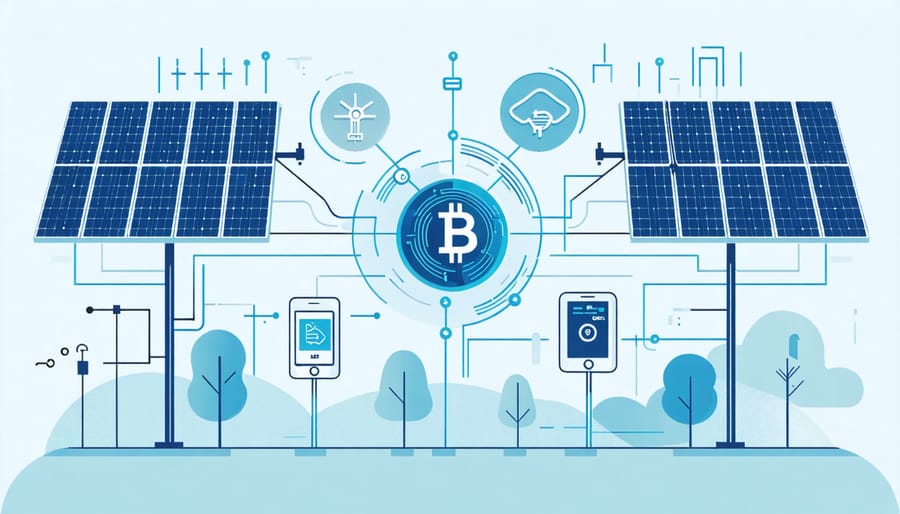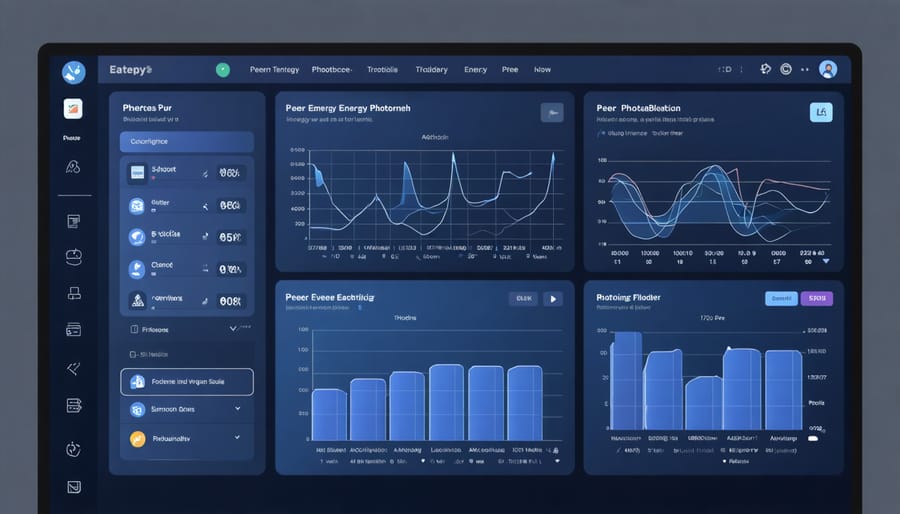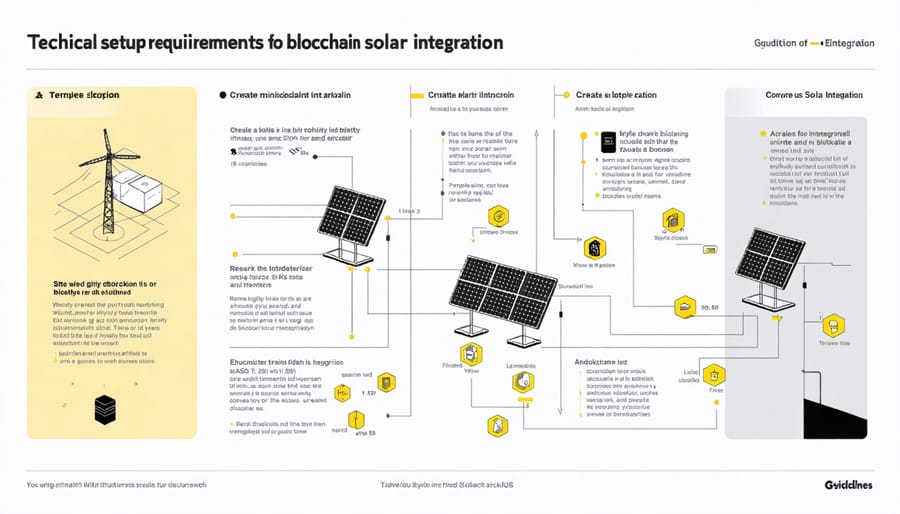Blockchain technology is revolutionizing the renewable energy sector, creating unprecedented opportunities for businesses to optimize their energy investments and operations. By leveraging blockchain technology fundamentals, organizations can now implement transparent, decentralized systems that enable peer-to-peer energy trading, automated smart contracts, and real-time monitoring of renewable energy production and consumption.
This innovation addresses two critical challenges in renewable energy adoption: efficient energy distribution and accurate tracking of renewable energy certificates (RECs). Major utilities and energy providers are already deploying blockchain solutions to streamline their operations, reducing transaction costs by up to 40% while ensuring immutable record-keeping of energy generation and consumption.
For business leaders and facility managers, blockchain integration represents a strategic advantage in the rapidly evolving energy landscape. The technology enables automated settlement systems, reduces administrative overhead, and provides tamper-proof verification of renewable energy sources—essential features for organizations committed to achieving their sustainability goals while maintaining operational efficiency.

How Blockchain Revolutionizes Solar Energy Transactions
Smart Contracts for Automated Energy Trading
Smart contracts serve as the technological backbone of automated energy trading systems in the renewable energy blockchain ecosystem. These self-executing contracts automatically facilitate peer-to-peer energy transactions when predefined conditions are met. For example, when a solar panel system generates excess electricity, the smart contract can automatically sell this surplus to nearby consumers at predetermined rates.
The automation process typically follows a structured workflow: energy production is measured through IoT devices, data is recorded on the blockchain, and transactions are executed based on real-time supply and demand. This eliminates the need for intermediaries and reduces transaction costs significantly.
Key features include automated payment processing, transparent pricing mechanisms, and programmable trading rules that can adjust to market conditions. Energy producers can set minimum selling prices, while consumers can specify maximum purchase rates. The system then matches buyers and sellers automatically, creating an efficient marketplace for renewable energy trading.
For facility managers and business owners, these automated systems provide precise tracking of energy production, consumption, and revenue, enabling better resource management and financial planning.
Peer-to-Peer Energy Trading Platforms
Peer-to-peer energy trading platforms leverage blockchain technology to create decentralized marketplaces where prosumers (producers-consumers) can directly trade renewable energy with other participants. These platforms enable real-time energy transactions, automated smart contracts, and transparent pricing mechanisms, eliminating the need for traditional intermediaries.
The marketplace functionality typically includes features such as automated matching of buyers and sellers, dynamic pricing based on supply and demand, and secure payment processing. Users can set their preferences for energy sources, pricing thresholds, and trading schedules, while the platform’s smart contracts automatically execute transactions when conditions are met.
Key benefits of P2P energy trading platforms include reduced energy costs for consumers, increased revenue potential for renewable energy producers, and improved grid stability through localized energy distribution. For example, businesses with excess solar production can sell their surplus energy to nearby facilities at competitive rates, creating new revenue streams while helping other organizations reduce their carbon footprint.
These platforms also provide detailed analytics and reporting tools, enabling participants to optimize their energy usage and trading strategies based on historical data and market trends.

Real Business Benefits of Blockchain Solar Integration
Cost Reduction Through Direct Trading
Direct trading through blockchain technology significantly reduces operational costs in renewable energy transactions by eliminating intermediaries and streamlining processes. Studies show that implementing blockchain-based energy trading can decrease transaction costs by 35-40% compared to traditional methods.
The cost reduction stems from several key factors. First, smart contracts automate trade settlements, reducing administrative overhead and minimizing human error. Second, peer-to-peer trading eliminates broker fees and third-party verification costs. Third, the transparent nature of blockchain reduces dispute resolution expenses and compliance costs.
A notable case study from Brooklyn Microgrid demonstrates how direct trading led to a 27% reduction in energy costs for participating businesses within the first year of implementation. Similarly, the Australian Power Ledger project reported average savings of 32% for commercial participants through direct energy trading.
The return on investment typically materializes within 18-24 months, depending on the scale of implementation. Initial setup costs, including software integration and infrastructure upgrades, are offset by reduced operational expenses and improved energy trading efficiency. Organizations implementing blockchain-based trading systems report an average payback period of 1.5 years for medium-sized operations.
Additional financial benefits include reduced credit risk through real-time settlement, lower working capital requirements, and improved cash flow management. These advantages make blockchain-based direct trading particularly attractive for businesses seeking to optimize their energy costs while supporting renewable energy adoption.
Enhanced Grid Stability and Energy Security
Blockchain technology is revolutionizing grid stability and energy security in renewable energy systems through its decentralized architecture and sophisticated smart contract capabilities. By enabling real-time monitoring and automated responses to supply-demand fluctuations, blockchain platforms help businesses maintain consistent power delivery while optimizing energy distribution across the network.
The technology’s distributed ledger system creates an immutable record of energy transactions, enhancing transparency and security in energy trading. This feature is particularly valuable for businesses operating microgrids, as it allows for seamless integration of multiple energy sources while maintaining operational stability. For example, a manufacturing facility in Germany implemented blockchain-based grid management and reduced its power fluctuations by 35% while improving overall energy security.
Smart contracts automatically execute predetermined protocols during peak demand or supply disruptions, ensuring continuous power availability. This automated response system significantly reduces the risk of outages and provides businesses with reliable backup options during critical operations. Additionally, blockchain’s peer-to-peer trading capabilities enable organizations to access multiple energy sources, creating redundancy in supply chains and enhancing overall energy security.
The technology also facilitates the integration of energy storage systems, allowing businesses to store excess renewable energy and deploy it strategically during high-demand periods or emergencies. This capability has proven particularly valuable for data centers and healthcare facilities where uninterrupted power supply is crucial for operations.
Implementation Case Study: Success in Action
Brooklyn Microgrid, a pioneering project launched in 2016, stands as a testament to the successful integration of blockchain technology in renewable energy systems. This innovative initiative, developed by LO3 Energy in partnership with Siemens, enables residents and businesses in the Brooklyn area to engage in peer-to-peer energy trading using blockchain technology.
The project began with just five participants and has since expanded to include over 50 prosumers (producers-consumers) actively trading solar energy within their community. The implementation utilizes a private Ethereum blockchain platform, which manages smart contracts and facilitates automated energy transactions between participants.
Key achievements of the Brooklyn Microgrid include:
– 30% reduction in energy costs for participating consumers
– 25% increase in return on investment for solar panel owners
– Creation of a resilient local energy marketplace
– Enhanced grid stability during peak demand periods
In Australia, Power Ledger’s deployment in Fremantle demonstrates another successful implementation. This project involves 40 households trading surplus solar energy through blockchain technology. The system has processed over 50,000 transactions and helped participants achieve average savings of 20% on their energy bills.
The technical infrastructure combines smart meters with blockchain nodes, enabling real-time energy monitoring and automated settlements. Smart contracts ensure transparent pricing and immediate transaction execution, while the distributed ledger maintains an immutable record of all energy trades.
Implementation challenges were addressed through:
– Comprehensive stakeholder education programs
– Phased rollout approach
– Regular system performance monitoring
– Continuous feedback integration from users
The success metrics demonstrate the viability of blockchain-based energy trading:
– 95% system uptime
– Average transaction processing time of under 30 seconds
– 100% accuracy in energy measurement and billing
– Zero security breaches since implementation
These case studies highlight how blockchain technology can effectively transform traditional energy markets into dynamic, peer-to-peer trading platforms while delivering tangible benefits to all participants. The successful implementations serve as blueprints for future projects, demonstrating the scalability and reliability of blockchain-based renewable energy systems.
Getting Started with Blockchain Solar Trading
Technical Requirements and Infrastructure
Implementing blockchain technology for renewable energy requires a robust infrastructure combining both hardware and software components. The foundation starts with existing solar energy systems integrated with smart meters and IoT devices for real-time data collection. Essential hardware components include secure servers, network infrastructure, and dedicated processing units for blockchain validation.
On the software side, organizations need a distributed ledger platform, typically built on established frameworks like Hyperledger Fabric or Ethereum Enterprise. Smart contract functionality requires reliable programming interfaces and secure digital wallets for energy credit transactions. Data encryption and cybersecurity protocols are crucial for protecting sensitive information and ensuring transaction integrity.
Network connectivity must be highly reliable, with redundant internet connections and backup systems to prevent disruption of energy trading. Organizations should also implement edge computing solutions to manage data processing loads and ensure swift transaction validation. Integration with existing energy management systems and billing infrastructure is essential for seamless operations.

Regulatory Compliance and Partnerships
Implementing blockchain technology in renewable energy requires careful attention to energy trading regulations and strategic partnerships. Organizations must comply with local utility commission requirements, data privacy laws, and energy market regulations. Key regulatory considerations include smart contract validation, cryptocurrency trading restrictions, and cross-border transaction compliance.
Successful implementation often involves partnerships with technology providers, energy utilities, and regulatory consultants. When selecting partners, organizations should evaluate their track record in blockchain deployment, understanding of energy markets, and compliance expertise. Look for partners who offer comprehensive solutions that include regulatory guidance, technical support, and integration capabilities.
Regular audits and compliance reviews are essential to maintain regulatory alignment. Organizations should establish clear governance frameworks that address data protection, transaction verification, and reporting requirements. Working with certified blockchain platforms and maintaining transparent documentation of all energy transactions helps ensure long-term compliance while building trust with regulators and stakeholders.
The integration of blockchain technology with renewable energy systems represents a transformative opportunity for businesses and organizations to enhance their energy operations. By implementing blockchain solutions, organizations can achieve greater transparency, improved efficiency, and reduced costs in their renewable energy transactions. The decentralized nature of blockchain ensures secure, tamper-proof records while enabling automated smart contracts that streamline energy trading and management. As the renewable energy sector continues to evolve, early adopters of blockchain technology will gain a competitive advantage in the market. We encourage decision-makers to explore blockchain implementation in their renewable energy strategies, starting with pilot projects and gradually scaling up based on proven results. The future of energy is decentralized, sustainable, and blockchain-enabled – the time to act is now.

